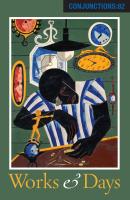On Valentine’s Day, Milo strings a horse-shaped piñata from the ceiling light in our living room, and I walk by twice before noticing it swaying there. The light is off and the horse is dark, but I am not unobservant. Part of me accepts a horse swinging in my periphery. Milo makes up a real reason for me to go back down the hall and, when I look for the space heater, I find the horse hanging. He dangles from a yellow jump rope, and I am so happy to see him in my house. Milo hands me the stick. “You need,” he says, “to kill a horse.”
About Us
Conjunctions editor Bradford Morrow.
A Letter from the Editor
Bard College’s literary journal Conjunctions publishes innovative fiction, poetry, and creative nonfiction by emerging voices and contemporary masters. For some four decades, Conjunctions has challenged accepted forms and styles, with equal emphasis on groundbreaking experimentation and rigorous quality. We are committed to launching and supporting the careers of unknown authors—William T. Vollmann, David Foster Wallace, Karen Russell, Isabella Hammad, and Raven Leilani all had some of their very first publications in Conjunctions—while providing a space for better-known voices—like John Ashbery, Sandra Cisneros, William H. Gass, Sigrid Nunez, or Joyce Carol Oates—to work outside audience expectations.The biannual anthology of new writing appears every spring and fall in print and e-book editions, and generally collects pieces that form a conversation around a central theme—new-wave fabulism, Caribbean writing, sanctuary, desire, climate change, and so on. Because these volumes are book-length, we’re able to publish long-form work, which other journals often cannot accommodate.
The free weekly online journal showcases the work of a single writer each week. It gives us a place to publish the exceptional work that doesn’t fit into the theme of a given anthology. Our website also features a multimedia vault of recorded readings, unavailable elsewhere; as well as full-text selections from the anthologies, and a constantly updated table of contents for the issue we’re putting together.
Published by Bard College, with editorial offices in New York City and Annandale-on-Hudson, New York, Conjunctions is a cornerstone of contemporary literary publishing. Since 1981, the journal has been a living notebook in which authors can write freely and audiences read dangerously.
